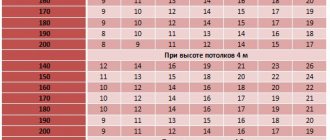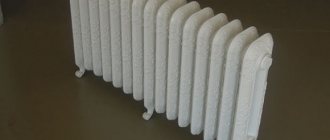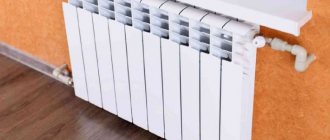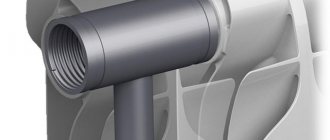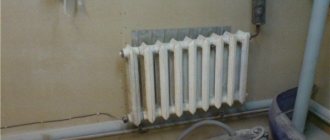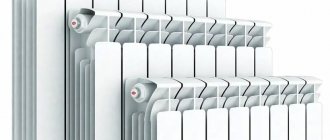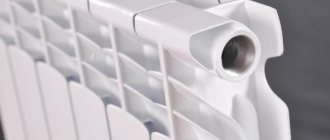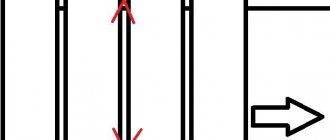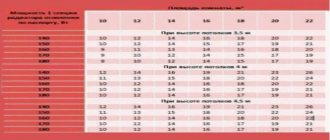Calculation of the number of batteries for a one-pipe system
This system is less productive than a two-pipe system, so it is extremely rare. The reason for ineffective heating is the serial connection of heating devices. First, the coolant passes through the first radiator, losing a certain amount of power there, then goes to the second, again losing a certain amount of heat - and so on along the entire length of the chain.
It is very difficult to calculate the exact power in this case, because the energy losses in each battery are different: in one - 1.9 kW, in another - 2.6, in the third - 3.2. With approximate calculations, it turns out that each subsequent radiator needs to be increased by 1 section. If there are, for example, seven batteries in the house and the first has seven elements in the system, then the second will have eight, and the last will have 13 sections.
This is cumbersome and inconvenient, so they install bypasses (bypass lines), transferring part of the hot water to distant batteries, or install a circulation pump into a direct pipeline at the inlet, which increases the speed of movement of the working medium several times.
Another way to create a comfortable microclimate in a private home is to purchase a gas or electric boiler with a power reserve of 30-50%. If the owner nevertheless decides to take the path of increasing the sections of the batteries, then when receiving a fractional result of the number of elements during calculations, it is rounded up in the nursery and bedroom, and rounded down in the kitchen and living room. The same principle is observed for rooms facing north and south.
Heat loss coefficient
It is impossible to calculate how powerful a battery in a room should be if all possible heat losses in it are not taken into account. Main heat leaks:
- Windows are the weakest “link” in a room if it does not have a balcony. In a house with conventional glazing, the calculation of bimetallic radiators should be carried out by adding an adjustment factor of 1.27. If a double-glazed window is installed in the room, then you will have to multiply by 1, and with a triple-glazed window - by 0.85.
- The size of the window also affects heat loss. So, if it is 10% of the floor area, then the coefficient is 0.8. In the event that the window is panoramic and is 50%, then by 1.2.
- If the thermal insulation of the walls is low, then the correction factor will be 1.27.
- External walls are also important when taking into account heat loss. If there is only one, then the calculated power should be multiplied by 1.1, if there are two or three, then by 1.2 or 1.3.
Each increase in the window by 10% adds 0.1 to the coefficient. If such amendments are not made to the calculations, it may turn out that with the boiler operating at full power, the apartment will be cool.
How the radiator is made is of considerable importance. For example, sectional models are convenient because if the calculation of bimetallic heating radiators was carried out incorrectly, the extra sections can be dismantled or, conversely, built up. Solid models can withstand pressures of up to 100 atmospheres, which has no analogues among batteries made of other types of metals, but if the installed device “does not cope” with its thermal power, then the entire panel will have to be replaced.
HOW TO CORRECTLY CALCULATE THE REQUIRED NUMBER OF HEATING RADIATORS
The number of heating radiators is calculated based on the following data: 41 watts of thermal power per 1 cubic meter.
if there is one in the room: window, door, external wall, i.e. standard conditions.
Let us calculate, for example, the number of radiators for a room measuring 3x4 m with a ceiling height of 2.7 m. First of all, we determine the volume of the room: 3x4x2.7 = 32.4 m3 Then we find the thermal power by multiplying the found volume by 41 - 32.4 * 41 = 1328.4 Watt. If, for example, the heat transfer from one section of a new radiator is 180 Watt, you can easily calculate the required number of radiators: 1328.4:180 = 6.3 (7 after rounding).
To heat the selected room you need 7 sections of radiators, each 180 Watt.
The following must be taken into account: if the room is not closed by a door, when calculating, the areas of the room itself and the adjacent room are summed up. This calculation is made for the accepted average coolant temperature of 70˚ C; lower temperatures require a corresponding increase in the number of sections. If a double-glazed window is installed in the room, then the number of sections is reduced, because it reduces heat loss by approximately 15-20%.
In the case of a corner room, its heat loss increases by 20%.
Heat loss, and therefore the number of sections, is affected by the number of floors, the degree of wall insulation, and decorative panels on radiators (only these can lead to a loss of heat transfer by 20-30%).
If the cast iron batteries already installed in the room need to be replaced with another type of radiator, then their number can be calculated very easily, since cast iron radiators have constant heat transfer (150 W) and center distance (600 mm): the number of sections of cast iron batteries is multiplied by 150 W and divide by the heat transfer of one section of the new radiator.
Then you can make the necessary adjustments for cold and heat.
For more accurate calculations, use the formula for calculating the number of heating radiators.
There are several approaches to calculating the number of heating radiators: standard, approximate (“by eye”), volumetric.
Standard
In accordance with the "SNP" per 1 sq.m.
you need 100 watts of radiator heat output. Then the power is calculated using the formula.
S x 100:P
P = power of one radiator section, S = area of the heated room.
Let's assume that the area of the room is 25 sq.m., and the power of one radiator section is 180 watts, then:
25x100:180=13.9, i.e. 14 sections will be needed.
If the room is corner or located at the end, the resulting number must also be multiplied by a factor of 1.2.
Exemplary
Since radiators are mass-produced and have standard sizes, it is generally accepted that with a ceiling height of 2.7 m by 1.8 sq.m.
one section is needed. Let's say for a room of 25 sq.m. you will need – 25:1.8=13.9 i.e.
Calculator for calculating the number of sections for bimetallic heating radiators
Go to calculations
Is it possible to calculate the number of sections by “eye”
There is an opinion that the number of sections of bimetallic and cast iron radiators should be the same. Actually this is not true. The heat transfer of one section of the former is slightly higher than that of the latter. If you decide to follow this simple rule, then your rooms will be cold. So why not just install a bimetallic radiator, increasing the number of sections “by eye”? Let's say 2 or 3 more sections than its cast iron predecessor had? Yes, many people do this. But this approach is also not entirely correct. In this matter, one cannot do without mathematical calculations.
Table 1. Calculation of the required number of sections per room
What you need to know when counting
There are many companies that provide services for calculating the number of battery sections. After all, in order to get the most accurate result, many factors should be taken into account:
- square footage of the room and ceiling height;
- thickness of wall structures
- type of window frames;
- type of room (living room, corridor, warehouse);
- ratio of wall area to window openings;
- climate of the region.
It is of great importance whether the room located above your room is heated and how many walls of the apartment are external. As you can see, a correct calculation will require too much accurate data, so it is better to entrust this important matter to professionals.
However, this does not mean that it is impossible to cope without outside help. Maybe! There would be time and desire.
You may be interested in information about what properties bimetal has.
Related video: Calculation of heat transfer of one section of an aluminum radiator
From “cast iron” classics to modern bimetal: which is better to choose?
To choose the right radiator, pay attention to the material from which the heating devices are made. Not so long ago, only cast iron radiators were available to consumers; there are other models on the modern market that differ in technical parameters, appearance, and service life
Cast iron
The metal has low thermal conductivity and therefore heats up slowly. To heat the radiator surface to 40–45 °C, the water in the system must correspond to 70 °C. The advantages include the slow cooling of the batteries after the boiler is turned off, resistance to aggressive environments and rust.
Photo 1. A cast iron radiator with low thermal conductivity and heavy weight is suitable for country houses.
Such heating devices do not require additional water treatment. Service life - more than 50 years. They can be installed both in spacious cottages and small private houses.
Radiators made of cast iron have a number of disadvantages related to heavy weight and appearance. Batteries must be periodically painted with durable paints. They are difficult to keep clean. Often, due to their unpresentable appearance, cast iron classics are hidden behind screens, which leads to heat loss.
If you have installed protective screens, add another 20% when calculating power.
Aluminum
Aluminum radiators are made by casting or extrusion with the addition of silicon. Unlike the classics, they are light in weight and installation, and have good thermal conductivity. Pleasant appearance excludes protective screens.
Photo 2. An aluminum radiator in a private house has good thermal conductivity and is easy to install.
These are the cheapest heating devices. But they have serious disadvantages: water preparation is necessary. The owner must install cartridges and filters and monitor the pH level. Otherwise, the protection of the inner layer of the devices will be compromised. The joints between the links may leak.
Attention! These radiators cannot be supplied with water through copper pipes - oxidation processes will begin. The product will last less than 15 years, allotted to it by the technical certificate
Steel
Reliable heating radiators with high thermal conductivity are made of steel. Lightweight, convenient for self-installation. Unpretentious products at an affordable price are chosen by owners of any type of housing construction. Attractive appearance, possibility of mounting options: horizontal and vertical, angular design.
The main disadvantage of steel panels is that they are subject to mechanical stress. Careless handling of the device reduces the service life from the stated 20 years.
Photo 3. Steel battery with high thermal conductivity, side connection method, suitable for any house construction.
Steel radiators are connected to the heating system using the bottom or side method. The bottom connection will cost the householder more than the side connection. Steel radiators should always be filled with water.
Bimetallic
In the manufacture of heat exchangers, two types of metal are used: steel pipes are placed in an aluminum body. The result is a more reliable design than devices made from one type of metal. They heat up quickly and transfer heat well. High-strength steel of the heat exchanger protects the system from corrosion. The radiators are light and aesthetic. They will create a comfortable environment in any type of private household.
The disadvantages include the high price, cracking during operation, since the two metals have different coefficients of thermal expansion.
Reference! Experts advise installing a venting valve on bimetallic radiators, and shut-off valves on the pipes. The service life in this case will be maintained: 25 years.
Battery Features
The radiator is called bimetallic because it is made of two metals: aluminum and steel. Structurally, it consists of a steel pipe housed in an aluminum casing. Steel provides strength and durability of the structure, and aluminum provides high thermal conductivity. Bimetallic radiators have the following advantages:
- High level of heat transfer (the radiator quickly heats the room).
- Long service life (up to 50 years).
- Strength provided by high quality steel (the battery can withstand large pressure surges).
- Resistant to corrosion, since only steel pipes come into contact with water. This is especially important during seasonal heating cleaning.
- Lightness of radiators, which facilitates their installation.
- Attractive appearance of models of different colors and designs, no need to hide them behind screens or curtains.
- Compactness, thanks to which the radiators fit into any interior.
Such radiators have a long service life
How to calculate heating without large errors
Very rarely, homeowners who decide to install an autonomous heating system opt for the option of natural coolant circulation, which is usually water, less often antifreeze. Installing a pump and boiler implies a constant consumption of electricity in the future, as a result of which it is most reasonable to convert all calculations into Watts
. However, the heat capacity of the system is usually calculated in J/(kg.°C), and the amount of heat generated by radiators is in calories. How to combine all these units of measurement? It's simple.
To begin with, one calorie is equivalent to the amount of heat spent to heat one gram of water by 1 degree. If we turn to heat capacity, then 1 calorie is equal to approximately 4.2 J, or more precisely, then 4.1868 J. Accordingly, for one liter of water, since it weighs 1 kilogram, this value will correspond to 4.2 kJ. In this case, 1 calorie is equal to 0.001163 Watt. hour, which means 1 kcal will be 1.163 watts. hour. That, in fact, is all that is needed to find the relationship between the radiated heat and the power of the electricity consumer.
Now, so that there are no other options but to correctly calculate the heating, let’s turn to the facts. To heat 1 square meter of a room, it is necessary to spend 90-125 W (as a rule, this is the power of one radiator section), depending on the climatic characteristics of the area. According to SNiP, the power of each radiator section must correspond to 100 kW
. And this is provided that the ceiling height does not exceed three meters, otherwise the power consumed will increase. Also, the power will have to be increased or decreased by approximately 15 degrees for every 10 degrees of deviation up or down from the average 70 degrees of heater temperature.
Also, for example, the system will be 10% less efficient if the influx of water into the radiators is through the lower holes, and the outflow through the upper ones. Based on the foregoing, it is easy to derive a formula for calculating the heat loss of the heating circuit, which, in fact, serves to effectively heat the room, since it occurs within its boundaries. Let's take on the determination of the amount of heat input for the boiler. There are always two pipes connected to the heat generator, the supply pipe, that is, the one through which hot water runs to the radiators, and the return pipe, in which the already cooled water flows back to the boiler.
Suppose the supply temperature is required to be 75 degrees, and the return temperature, due to heat loss, will be 50 °C, what in this case is the power of the boiler, the water flow of which is 16 liters per minute? We already know that to heat a liter of water by 1 degree it is necessary to spend 1.163 watts per hour. During this time, 16 will pass through the boiler. 60 = 960 liters. Therefore, taking into account the temperature difference T = t1 – t2 = 75 – 50 = 25 °C, we obtain a boiler power of 1.163. 25. 960 = 27912 Watts. hour or 27.912 kW.
There is another way to calculate a heating system, based on the specific power required to heat 10 square meters, depending on the characteristics of the region. By definition, in the Northern regions the specific power of the boiler Wsp should be 1.2-1.5 kW per 10 m2, in the Central regions this value is already 1.2-1.5 kW per the same area, and in the Southern regions - 0.7 -0.9 kW. As a rule, calculations are made for the above-mentioned 10 squares with an average ceiling height of 2.7 meters, the boiler power is determined by the formula Wcat = S.Wud / 10, where S is the area of the room. For typical houses, data can be taken from the table.
| House area, m2 | Boiler power, kW |
| 60 — 200 | up to 25 |
| 200 — 300 | 25 — 35 |
| 300 — 600 | 35 — 60 |
| 600 — 1200 | 60 — 100 |
Determination by room area
The easiest way is to calculate bimetallic heating radiators by area , but in this case you need the ceiling height be about 2.5 meters . In accordance with SNiP, the load per meter is 100 Watts - this standard is established for the central zone of the Russian Federation. Note that in the regions of the Far North this value is much higher.
In the “standard” case, it is necessary to multiply the area of the room by 100 , as a result of which we obtain the standard heat consumption power . Then we divide the obtained value by the rated heat transfer of one section of the bimetallic radiator (it is indicated in the technical description or passport for the device) - the final figure shows how many sections of the bimetallic radiator are needed.
Calculation stages
It is necessary to calculate the heating parameters of a house in several stages:
- calculation of heat loss at home;
- selection of temperature conditions;
- selection of heating radiators by power;
- hydraulic calculation of the system;
- boiler selection.
The table will help you understand what power radiator is needed for your room.
Heat loss calculation
The thermal engineering part of the calculation is performed on the basis of the following initial data:
- thermal conductivity of all materials used in the construction of a private house;
- geometric dimensions of all building elements.
The heat load on the heating system in this case is determined by the formula: Mk = 1.2 x Tp, where
Tp - total heat loss of the building;
Mk - boiler power;
1.2 - safety factor (20%).
For individual buildings, heating calculations can be made using a simplified method: the total area of the premises (including corridors and other non-residential premises) is multiplied by the specific climatic power, and the resulting product is divided by 10.
The value of the specific climatic power depends on the construction site and is equal to:
- for central regions of Russia - 1.2 - 1.5 kW;
- for the south of the country - 0.7 - 0.9 kW;
- for the north - 1.5 - 2.0 kW.
A simplified methodology allows you to calculate heating without resorting to the expensive help of design organizations.
Temperature conditions and selection of radiators
The mode is determined based on the temperature of the coolant (most often it is water) at the outlet of the heating boiler, the water returned to the boiler, as well as the indoor air temperature.
The optimal regime, according to European standards, is the ratio 75/65/20.
To select heating radiators, before installing them, you should first calculate the volume of each room. For each region of our country, the required amount of thermal energy per cubic meter of space has been established. For example, for the European part of the country this figure is 40 W.
To determine the amount of heat for a specific room, you need to multiply its specific value by cubic capacity and increase the resulting result by 20% (multiply by 1.2). Based on the obtained figure, the required number of heating devices is calculated. The manufacturer indicates their power.
For example, each fin of a standard aluminum radiator has a power of 150 W (at a coolant temperature of 70°C). To determine the required number of radiators, you need to divide the amount of thermal energy required by the power of one heating element.
Hydraulic calculation
There are special programs for hydraulic calculations.
One of the most expensive stages of construction is the installation of the pipeline. A hydraulic calculation of the heating system of a private house is needed to determine the diameters of the pipes, the volume of the expansion tank and the correct selection of the circulation pump. The result of the hydraulic calculation is the following parameters:
- Coolant flow in general;
- Loss of heat carrier pressure in the system;
- Pressure loss from the pump (boiler) to each heating device.
How to determine coolant flow? To do this, you need to multiply its specific heat capacity (for water this figure is 4.19 kJ/kg * deg. C) and the temperature difference at the outlet and inlet, then divide the total power of the heating system by the result obtained.
The diameter of the pipe is selected based on the following condition: the speed of water in the pipeline should not exceed 1.5 m/s. Otherwise the system will make noise. But there is also a lower speed limit - 0.25 m/s. Pipeline installation requires an assessment of these parameters.
If this condition is neglected, airing of the pipes may occur. With correctly selected sections, a circulation pump built into the boiler is sufficient for the functioning of the heating system.
The pressure loss for each section is calculated as the product of the specific friction loss (indicated by the pipe manufacturer) and the length of the pipeline section. In the factory specifications they are also indicated for each fitting.
Choosing a boiler and a little economics
The boiler is selected depending on the degree of availability of a particular type of fuel. If gas is supplied to the house, there is no point in purchasing solid fuel or electric. If you need to organize hot water supply, then the boiler is not selected based on heating power: in such cases, they choose to install double-circuit devices with a power of at least 23 kW. With lower productivity, they will provide only one water collection point.
Calculation methods
The most popular calculation methods are made using the actual area and volume of the heated room.
By area
Calculation by area is the simplest, but allows you to determine the number of sections only in apartments with a height of about 2.5 m. SNiP provides for a load per meter of 100 W. This is the standard for the middle zone. In the north beyond latitude 60, it can be significantly higher.
Multiplying the area by 100, we obtain the power of standard heat consumption. Dividing it by the rated heat transfer of the fin, we obtain the number of fins for heating.
By volume
Calculation by volume is used where ceilings are higher than 2.6 m. According to the standards, for heating cubic meters. Depending on the type of building, the following is required:
- for panel 41 W,
- for brick 34 W.
Multiplying the area by the height of the room we get the calculated volume in cubes.
By multiplying the number of cubic meters by the standard heat consumption of your home, we obtain the standard heat consumption power, which we use in the same way as in paragraph 2.1.
